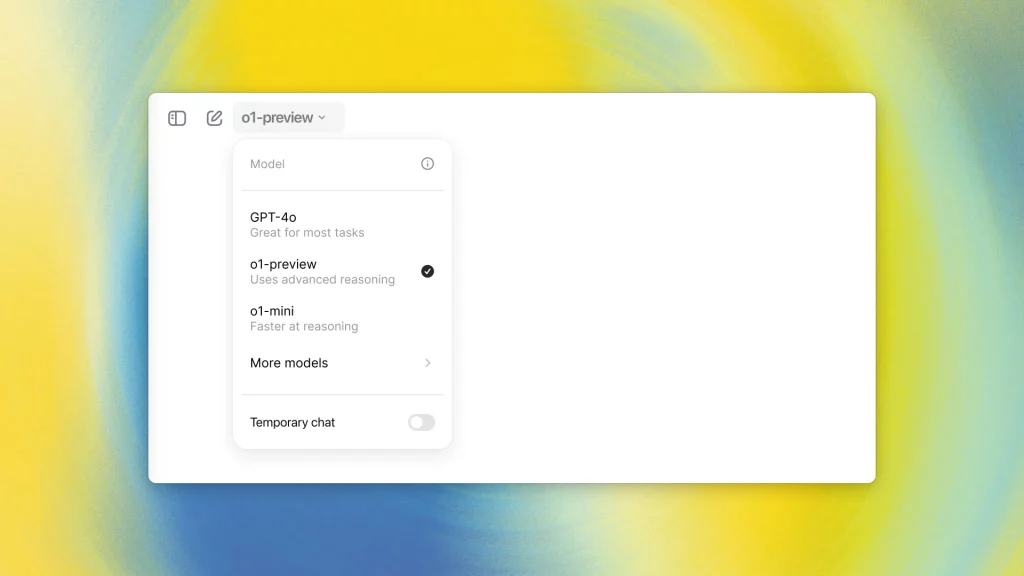While GPT-4 has already transformed the way we interact with AIs, the o1 models take this revolution to a whole new level. Withperformance comparable to that of PhD students in technical fields, these models are paving the way for new applications.
What is OpenAI o1?
OpenAI o1 is a new series of AI models, designed specifically to handle tasks requiring deep reasoning ability.

In contrast to its predecessors, which focus primarily on speed of response and text generation, o1 is designed to “take time” to think.
This approach improves the quality of answers on complex topics, such as solving mathematical problems or creating code.
Performance
During internal testing, OpenAI compared GPT-4 with o1 on a series of academic challenges.
In a qualifying test for the International Mathematical Olympiad, GPT-4 managed to solve 13% of the problems, while o1 achieved an impressive 83%.
When it came to programming, o1 showed remarkable results, ranking in the 89th percentile in code competitions on the Codeforces platform.
These performances demonstrate the ability of this model to tackle complex tasks that other AI models failed to solve correctly.
Enhanced security
One of the main challenges of artificial intelligence lies in security and the possibility of users exploiting loopholes (known as “jailbreaking”).
OpenAI has implemented a new security approach for o1, enabling AI to reason through complex security guidelines.
In jailbreaking tests, GPT-4 scored 22 on a scale of 100, while o1 achieved an impressive 84.
This means that o1 is much more resistant to attempts to circumvent security measures.
OpenAI o1-mini: The Solution for Developers
In addition to o1, OpenAI has also introduced o1-mini, a smaller, faster model designed for specific tasks, including coding.
This model is optimized for developers and small teams who need AI that can reason quickly and efficiently about programming problems without the full power of o1.
This model, although less powerful on extremely complex tasks, remains 80% cheaper and consumes fewer resources, making it an attractive option for less complex development projects.
Seasoning applied to development
The o1-mini model is particularly effective in code generation and correction, with an ability to understand and resolve bugs faster than previous versions of OpenAI.
Developers can thus gain in productivity, particularly for repetitive or complex tasks.
Features such as detecting errors in code or suggesting optimized solutions make o1-mini a valuable tool for programmers.
How Reasoning Works in OpenAI o1?
One of the main advances of o1 models lies in their ability to “think” before providing an answer.
Contrary to previous AIs that generated answers quickly, often without checking the consistency of their reasoning, o1 takes a more methodical approach.
The model is able to evaluate several strategies for solving a problem, identify errors in its own reasoning and adjust its responses accordingly.
This new approach is similar to the way a human would approach a difficult problem: step back, consider different possible solutions, and learn from mistakes.
This reasoning ability significantly improves o1’s performance on tasks requiring critical thinking and analytical skills.
Applications of Models o1 and o1-mini
The OpenAI o1 models are specially designed to meet the needs of researchers, developers and professionals in complex fields. Here are a few examples of potential applications:
- Life science research: Biotech researchers can use o1 to analyze cell sequencing data or generate hypotheses based on complex biological models.
- Advanced physics: Physicists working in fields such as quantum optics can turn to o1 to solve complex mathematical equations or simulate theoretical physics experiments.
- Software development: For developers, o1-mini represents an effective solution for automating code generation, resolving bugs, or even creating entire applications from a simple natural language description.
- Education and training: In academic environments, these models could be used to help students and teachers solve complex problems in mathematics, chemistry, or biology.
Limits and Next Steps
Although the o1 and o1-mini models represent a significant step forward, they are not without their limitations.
For example, o1, in its current version, is not capable of browsing the web for real-time information or interacting with files or images.
These features, present in GPT-4, are not yet integrated into o1, but OpenAI plans to add them in future updates.
Next generation of templates
The o1 series is just the beginning. OpenAI has announced that it is already working on improvements for the next generation of models, which should include additional capabilities such as web browsing and multimedia file integration.
These features will make o1 even more versatile and useful in a variety of professional contexts.
Read our article on GPT 4o:
- Chat GPT-4o: The AI that redefines Multimodal Interaction
- GPT-4o Mini: Performance, speed and economy for AI
- Comparative between GPT-4o and GPT-4o-mini: which AI model to choose?
The OpenAI o1 and o1-mini models mark a new era in artificial intelligence, with a focus on reasoning and complex problem solving.
Thanks to their ability to “think before answering”, these models far surpass their predecessors in fields such as mathematics, programming and science. As AI continues to evolve, it’s clear that the reasoning capabilities of o1 and o1-mini will open up new vistas for researchers, developers and professionals around the world.
AI NEWSLETTER
Stay on top of AI with our Newsletter
Every month, AI news and our latest articles, delivered straight to your inbox.

CHATGPT prompt guide (EDITION 2024)
Download our free PDF guide to crafting effective prompts with ChatGPT.
Designed for beginners, it provides you with the knowledge needed to structure your prompts and boost your productivity
With this ebook, you will:
✔ Master Best Practices
Understand how to structure your queries to get clear and precise answers.
✔ Create Effective Prompts
The rules for formulating your questions to receive the best possible responses.
✔ Boost Your Productivity
Simplify your daily tasks by leveraging ChatGPT’s features.
Similar posts
GPT-4o Mini : AI performance, speed and economy
The GPT-4o-mini model is distinguished by several specific features that make it unique and particularly suitable for certain types of application. Here are the main features of GPT-4o-mini: Compact size …
GPT-4o vs. GPT-4o-mini: which AI model to choose?
OpenAI has recently introduced two new models that are generating a lot of interest: GPT-4o and GPT-4o-mini. Although these models share a common technological base, they are designed to meet …
Chat GPT-4o : The AI that redefines multimodal interaction
OpenAI recently lifted the veil on GPT-4o, a revolutionary artificial intelligence model that combines text, audio and image processing capabilities in real time. This major technological breakthrough paves the way …


